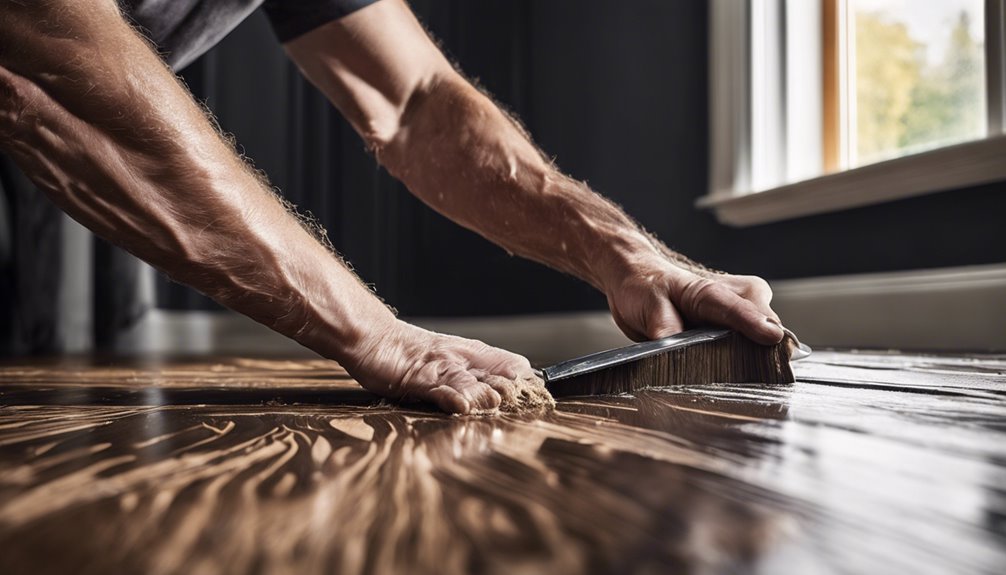To fix gaps in your laminate flooring, start by identifying the cause, like humidity changes or improper installation. Use a putty knife to apply wood filler or paintable caulk to seal gaps. Alternatively, consider using floor gap covers for a quick solution. If shifting planks are an issue, securing them with flooring adhesive can help. For long-term maintenance, keep indoor humidity between 30%-50% and regularly check for gaps. Address these issues promptly to maintain your floor's integrity. There's more to explore about effective maintenance strategies that can enhance the life of your flooring.
Understanding the Causes
Understanding the causes of gaps in laminate flooring is essential for effective repairs. One primary reason is the lack of proper expansion gaps during installation. Laminate flooring needs room to expand and contract, especially with changes in humidity levels. If these gaps are too small or nonexistent, the flooring can buckle or separate.
Additionally, fluctuating humidity levels can lead to the boards swelling or shrinking, which contributes to those unsightly gaps. High humidity can cause the laminate to expand, while low humidity can lead to contraction. Being aware of these factors helps you maintain your flooring and make informed decisions about repairs. By addressing these causes, you can enjoy a more stable and aesthetically pleasing laminate floor in your home.
Tools and Materials Needed
To effectively address gaps in your laminate flooring, having the right tools and materials on hand is key. Start with laminate repair kits, which often include fillers to match your flooring's color and texture. You'll also need a putty knife for applying these fillers neatly into the gaps. A soft cloth will help you wipe away any excess material. Additionally, having flooring adhesive is vital if the gaps are due to shifting planks; it'll help secure the boards back in place. A measuring tape can assist you in determining the size of gaps, while a utility knife may be needed for any necessary adjustments. With these essentials, you're well on your way to restoring your laminate flooring's beauty and integrity.
Quick Fix Techniques
While gaps in laminate flooring can be frustrating, there are several quick fix techniques you can use to address them effectively. These temporary measures can help you achieve a better appearance while you consider long-term solutions.
| Technique | Description | Pros |
|---|---|---|
| Gap Filling with Caulk | Use paintable caulk to fill gaps | Easy to apply |
| Wood Filler | Apply wood filler for a seamless look | Matches flooring color |
| Floor Gap Covers | Use plastic or wood covers | Quick installation |
| Shims | Insert shims to stabilize planks | Affordable and effective |
| Tension Rods | Use tension rods to hold planks tight | Non-invasive solution |
These techniques can help you maintain your flooring's appearance until you decide on a more permanent fix.
Long-Term Solutions
After applying quick fixes to manage gaps in your laminate flooring, it's time to contemplate more permanent solutions that can restore the integrity and appearance of your floors. Consider installing expansion joints during the flooring process, as these allow for natural movement and can prevent future gaps. Proper humidity control is also essential; you should maintain indoor humidity levels between 30% and 50% to avoid expansion or contraction of the laminate. Using a dehumidifier or humidifier can help you achieve this balance. Additionally, if gaps persist, you might want to consult a professional to assess the installation and recommend corrective measures. By addressing these factors, you'll guarantee your laminate flooring remains beautiful and functional for years to come.
Maintenance Tips for Longevity
Regular maintenance is key to ensuring your laminate flooring lasts for years. Start with effective cleaning techniques; use a microfiber mop and a gentle cleaner designed for laminate. Avoid excess water, as it can seep into seams and cause damage. Implement preventive measures by placing mats at entrances to catch dirt and debris, and use felt pads under furniture to prevent scratching. Periodically check for gaps or loose planks and address them promptly. Avoid dragging heavy items across the floor, which can lead to wear and tear. Finally, maintain a stable indoor humidity level to minimize expansion and contraction. With these simple steps, you'll keep your laminate flooring looking great and performing well for the long haul.
Frequently Asked Questions
Can I Use Regular Wood Glue for Laminate Gaps?
You might wonder if regular wood glue's effective for filling gaps in laminate. Unfortunately, it isn't designed for that purpose and can lead to issues like warping or damage. Instead, consider using specialized gap fillers or sealants specifically made for laminate flooring. These alternatives provide better adhesion and flexibility, ensuring a more durable solution. Always check product compatibility for the best results, and maintain the freedom of your flooring's appearance and integrity.
Will Gaps Affect My Laminate Flooring Warranty?
Yes, gaps can affect your laminate flooring warranty coverage. Most manufacturers specify that proper installation and maintenance are vital, and gaps could indicate improper installation or environmental issues like humidity changes. If the gaps are caused by these factors, you might find your warranty voided. It is important to understand the gap causes and address them promptly to maintain your warranty and enjoy your flooring without worries. Keep an eye on those gaps!
What Are Signs of Moisture Damage in Laminate?
Imagine stepping onto your beautiful laminate floor only to find it feels spongy or looks warped. Those are moisture indicators that shouldn't be ignored. You might notice discoloration, swelling, or even a musty smell, all signs of laminate deterioration. If you see these issues, it's essential to address them quickly. Ignoring moisture damage can lead to costly repairs and limit your freedom to enjoy your space. Stay vigilant and protect your investment!
How Do I Prevent Future Gaps in Laminate Flooring?
To prevent future gaps in your laminate flooring, focus on maintaining proper humidity control in your home. Keep the indoor humidity levels between 30-50% to minimize expansion and contraction. Additionally, make sure there are adequate expansion joints around the perimeter of your flooring to allow for natural movement. Regularly check for changes in temperature and moisture, as these can greatly affect the integrity of your laminate and lead to unsightly gaps.
Is It Possible to Replace a Single Plank?
Yes, it's definitely possible to replace a single plank in laminate flooring. For this flooring repair, start by gently removing the damaged plank, ensuring you don't disturb the surrounding pieces. You can then slide a new plank into place, securing it as needed. Just make sure the new plank matches the existing flooring in color and style for a seamless look. With a bit of care, you'll restore your floor's appearance and functionality.




